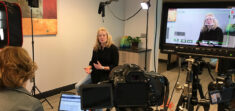It’s almost the most wonderful time of the year (or at least the summer)! The 31st annual
starts on Sunday and it’s shaping up to be finomenal. This highly anticipated series from the Discovery Channel always makes a splash—attracting
with its jaw-dropping footage, research-driven programming, and celebrity content.
No matter your industry or target audience, you can learn a lot about launching a successful campaign from the pros at the Discovery Channel. After all, they’ve found the golden ticket to getting viewers to tune in for over three decades. Here are five of the top marketing lessons you can learn from Shark Week.
1. Build anticipation
Anticipation can be an extremely valuable tool as a marketer. As best-selling author
pointed out at our
conference, audiences around the world have a need for closure—and you can keep them engaged by creating a “curiosity gap” that they seek to fill by viewing your content.
Though Shark Week doesn’t officially start until Sunday, the Discovery Channel began building anticipation around the event two months ago through a press release, social promotion, and more. A
announcing this year’s start date has since gained 4,338 likes and 2,005 retweets—including some of the below that were retweeted on the @SharkWeek handle, illustrating followers’ sheer excitement:

By building in two months to ramp up their promotions, the Discovery Channel gave themselves ample opportunity to expand their reach and capitalize on the social buzz surrounding Shark Week. As marketers, we should take note here. No matter what you’re promoting—from an upcoming event to a downloadable asset to a webinar—make sure you build in enough time to get your audience excited about your new offering. Consider doing the following:
-
Write blog posts that give your audience a preview of the best practices you’ll be presenting during an upcoming event.
-
Launch email campaigns that provide targets with a sneak peek into the research you’ll be sharing in your new whitepaper.
-
Share a short webinar promo video on your social channels to capture your audience’s attention and encourage registration.
2. Seek valuable partnerships
There’s no question that the Shark Week team understands the value of partnerships. From creating gear with
to stuffed animal clothing with
, they continually find unique ways to promote their content to new audiences. This year,
even partnered with the Discovery Channel to create an augmented reality experience of swimming with sharks.
And let’s not forget their celebrity content. Over recent years, viewers have had the opportunity to watch everything from Olympian
going “fin-to-fin” with a CGI shark to
having his first-ever shark encounter (which ended up being more of an attack!). By associating these top names with special programming, the Discovery Channel has been able to gather even more buzz and boost their viewership.
The overarching lesson here is simple: By establishing worthwhile partnerships—whether for promotional or content purposes—you can expand your reach. Of course, there are a lot of different paths you can take here. If it’s within your budget, consider sponsorship opportunities to boost your brand awareness. This can include anything from sponsoring an industry conference to a new research report that’s related to your field. If you have a corporate blog, you could also establish a partner post program in which an SME from each organization writes a relevant guest blog for the other’s publication—empowering both companies to reach a new market.
3. Captivate your audience with video
It’s no secret: Video is one of the most powerful mediums through which you can tell compelling stories. Of course, video is at the heart of the Shark Week content itself, but it also plays a major role in the Discovery Channel’s associated promotions. If you go to the Shark Week
, you’re surrounded by video—from the 2019 promo clip to various full episodes of content from previous years that you can watch for free. And on the
twitter handle, a large quantity of the posts include video content, whether they’re short clips or gifs—making it even easier to catch followers’ eyes as they’re scrolling through their newsfeed.
In today’s marketplace, this high use of promotional video content comes as no surprise. After all, according to our recent
, 53% of adults engage with a brand after watching video on social media—and 76% have made a purchase after viewing a video. By incorporating video into your marketing campaigns, you can show your products or services in action. Beyond general promo assets, consider creating
to boost your audience engagement,
to curate related content, and corporate gifs to breathe some new life into your social channels.
4. Amp up the drama
This year’s Shark Week promo materials feature a “So good you’ll scream” tagline—and a video that plays off the fear factor that drives so many viewers to tune in on an annual basis. The promo (as seen at the top of
) doesn’t even feature a shark, and instead focuses on how other underwater creatures may react to seeing one.
As the Discovery Channel exemplifies, you shouldn’t be afraid to have a little fun with your promotional content. No matter your audience or subject matter, there’s a way to add a little humor into your assets. This can be particularly valuable in videos, which are easily shareable through various platforms (and have the potential to go viral!). Just be sure to test different approaches to see which tone resonates best with your audience.
And think of how you can add a bit of drama, too. Even when there’s no underwater predator involved, there’s a way to up the ante a bit. Consider the knowledge gap you’re trying to fill with a particular offering and why your audience needs the information you’re providing to reach a certain goal, beat out their competitors, boost revenue, etc.—and call this out explicitly.
5. Consider going live
While this year’s Shark Week content will, of course, be available on the Discovery Channel, viewers will also be able to stream every program live on the Discovery GO app and Discovery.com. In the age of cord cutters where
is king, this distribution strategy empowers the Discovery Channel to increase their viewership.
While your brand may not have this type of long-form content to share, there are a variety of ways you can add
into your marketing mix. Consider
scenes from an industry event, interviews with subject matter experts, or your team’s presentation on a hot topic. By doing so, you can expand your reach, enhance brand awareness, and create unique content that you can repurpose into video on demand (VOD) assets down the line.
Whether you’re looking to amp up your current promotional content or try a new outreach approach, there are a lot of marketing tips and tricks you can learn from Shark Week. But more generally speaking, the overall success of this Discovery Channel content tells one simple truth: Video is a powerful medium through which to tell your stories and engage with your audience.
Interested in incorporating more video into your marketing toolbox?
.




